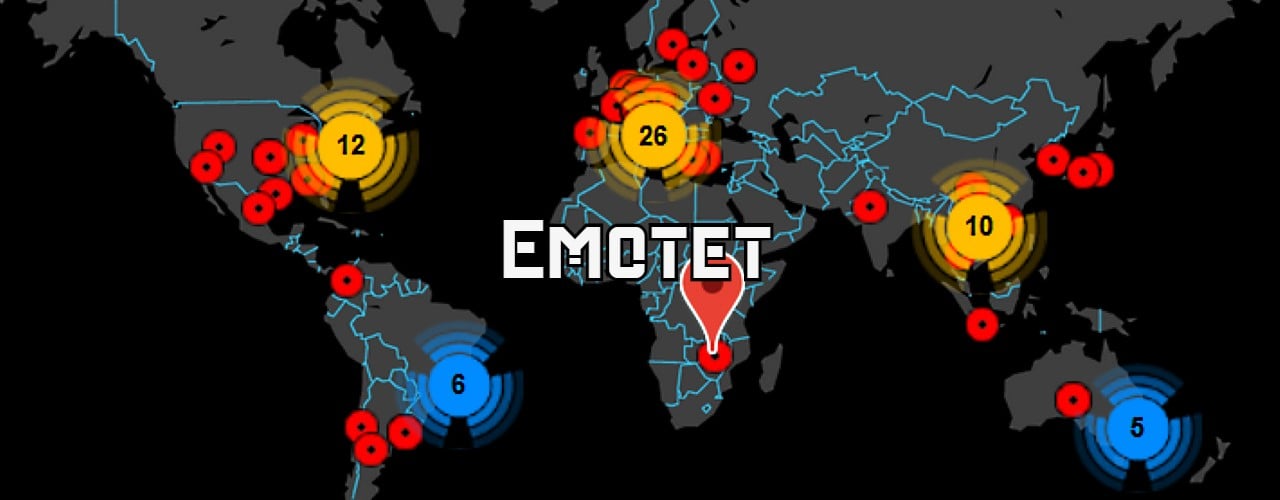Network administrators are strongly advised to block all associated IP addresses to prevent their devices from being recruited into the newly reformed Emotet botnet.
Update 11/16/21: Updated to include source of Operation RA.
Emotet malware is back and rebuilding its botnet via TrickBot

Emotet would then use infected devices to perform other spam campaigns and install other payloads, such as the QakBot (Qbot) and Trickbot malware. These payloads would then be used to provide initial access to threat actors to deploy ransomware, including Ryuk, Conti, ProLock, Egregor, and many others.
At the beginning of the year, an international law enforcement action coordinated by Europol and Eurojust took over the Emotet infrastructure and arrested two individuals.
German law enforcement used the infrastructure to deliver an Emotet module that uninstalled the malware from infected devices on April 25th, 2021.
Emotet returns after law enforcement operation
Today, Emotet research group Cryptolaemus, GData, and Advanced Intel have begun to see the TrickBot malware dropping a loader for Emotet on infected devices.
This is our 3rd anniversary of Cryptolaemus1. Thanks for all the follows and sharing of intel these past 3 years! To celebrate, Ivan has released a new version of Emotet because he feels left out and wants to be part of the party. More details coming soon. As always watch URLHaus pic.twitter.com/Qwvel32ibB
— Cryptolaemus (@Cryptolaemus1) November 15, 2021
While in the past Emotet installed TrickBot, the threat actors are now using a method that the Cryptolaemus group calls "Operation Reacharound," which rebuilds the botnet using TrickBot's existing infrastructure
Emotet expert and Cryptolaemus researcher Joseph Roosen told BleepingComputer that they had not seen any signs of the Emotet botnet performing spamming activity or found any malicious documents dropping the malware.
This lack of spamming activity is likely due to the rebuilding of the Emotet infrastructure from scratch and new reply-chain emails being stolen from victims in future spam campaigns.
Cryptolaemus has begun analyzing the new Emotet loader and told BleepingComputer that it includes new changes compared to the previous variants.
"So far we can definitely confirm that the command buffer has changed. There's now 7 commands instead of 3-4. Seems to be various execution options for downloaded binaries (since its not just dlls)," Cryptolaemus researchers told BleepingComputer.

Advanced Intel's Vitali Kremez has also analyzed the new Emotet dropper and warned that the rebirth of the malware botnet would likely lead to a surge in ransomware infections.
"It is an early sign of the possible impending Emotet malware activity fueling major ransomware operations globally given the shortage of the commodity loader ecosystem," Kremez told BleepingComputer in a conversation.
"It also tells us that the Emotet takedown did not prevent the adversaries from obtaining the malware builder and setting up the backend system bringing it back to life."
Samples of the Emotet loader dropped by TrickBot can be found at Urlhaus.
Kremez told BleepingComputer that the current Emotet loader DLL has a compilation timestamp of "6191769A (Sun Nov 14 20:50:34 2021)."
Defending against the new Emotet botnet
Malware tracking non-profit organization Abuse.ch has released a list of command and control servers utilized by the new Emotet botnet and strongly suggests network admins block the associated IP addresses. . ."
READ MORE
RELATED CONTENT
Lock up your Office macros: Emotet botnet back from the dead with Trickbot links
Nice to have nearly a year off from that malspam threat, but now it's returned
The Emotet malware delivery botnet is back, almost a year after law enforcement agencies bragged about shutting it down and arresting the operators.
The SANS Institute's Internet Storm Centre (ISC) was one of many organisations to confirm overnight that the spam-based malware delivery network was back online following police raids in January 2021 targeting its command and control infrastructure.
Detailing emails the ISC had seen circulating in the wild with malicious Word, Excel, and .zip archive files attached, the org's Brad Duncan blogged: "These emails were all spoofed replies that used data from stolen email chains, presumably gathered from previously infected Windows hosts."
The revival of Emotet is serious because in its final form the Windows malware network was increasingly being used to deliver ransomware, as well as the traditional online banking credential-stealing code it was previously best known for. Typically spam emails sent by Emotet contain a document in a common file format with embedded macros.
The messages involve references to current news events, fake invoices, or memos from corporate superiors, and suchlike, to deceive users into opening the attached file and running the macros, which drop the Emotet malware itself onto the host computer. In the past Emotet has been seen delivering ransomware from well-known criminal gangs such as Conti, Ryuk, and more. . .


No comments:
Post a Comment